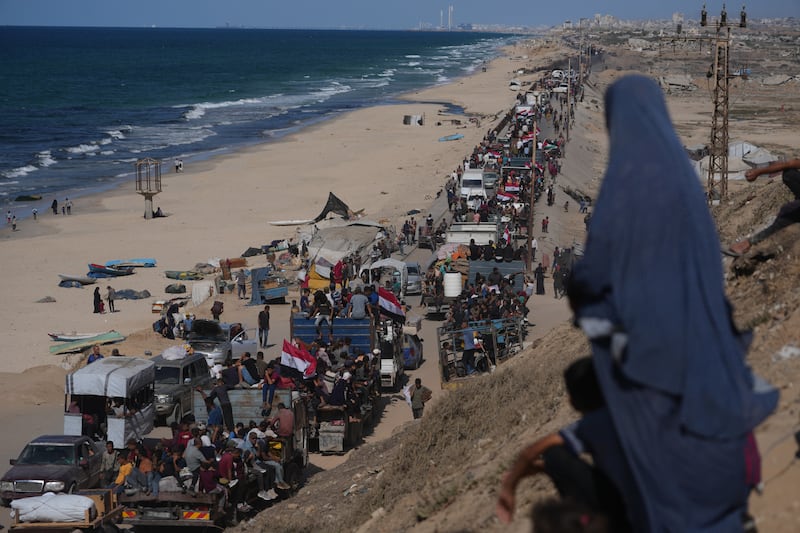The ceasefire between Israel and Hamas continued Thursday, but remained in a fragile state with each side accusing the other of violating the terms of the agreement.
The return of deceased hostages is slow and may be delayed, and aid to Palestinians is trickling in after Israeli officials threatened to cut off the supply.
President Donald Trump called out Hamas online Thursday, threatening them to stop its acts of violence in Gaza against Palestinians as the region reacts to Israeli withdrawal.
The region celebrated Monday as Trump’s peace deal directed Hamas to release the remaining 20 living hostages in return for a Palestinian prisoner swap. But with conflicts still erupting inside Gaza and tensions heightened amid the ceasefire rollout, it remains unclear how the second phase will work.
Trump threatens Hamas
In the Oval Office on Tuesday, Trump was asked about a timeline for Hamas to disarm under the deal’s second phase. He said if the group doesn’t disarm, “we will disarm them” and added that it could happen “perhaps violently.”
Trump shared a post online Thursday threatening the group, saying if it continues to kill people in Gaza, which was not part of the agreed-upon first phase of the deal, “we will have no choice but to go in and kill them.”
While Israeli troops withdrew and a ceasefire currently means a breath of relief for Palestinians in Gaza, Hamas has been trying to reclaim power in the war-torn region.

As many as 27 people were dead earlier this week after Hamas militants and armed members of the Dughmush family in Gaza City clashed. Hamas gunmen exchanged heavy fire with members of the clan and said it was trying to restore order and deal with the resistance.
Under Trump’s ceasefire plan, Gaza would be de-radicalized and terror-free, meaning Hamas would disarm. Members of the militant group who want to leave Gaza would be given amnesty and provided safe passage. It’s currently unclear what the group’s future will look like.
Delayed hostage return
On Tuesday, Israel demanded Hamas return the remaining deceased hostages and warned Palestinians to respect the current military line.

It was understood that it would take time for Hamas to recover and return all of the deceased hostages. However, Hamas said the war-torn Gaza Strip makes it logistically difficult to locate all of the bodies and it had given Israel all of the bodies it can access. Israel believes Hamas is strategically delaying the return.
The Israel Defense Force shared Thursday that it now had identified the bodies of nine hostages returned. One body returned to Israel earlier this week was not a hostage. At the time of the ceasefire, there were believed to be 28 deceased hostages in Gaza.
The families of Inbar Hayman and IDF Sgt. Maj. Muhammad Al-Atresh were notified that their bodies had been brought back for burial.
Hayman, a 27-year-old, was taken during the Oct. 7, 2023, attack at the Nova music festival, and her death was pronounced on Dec. 15, 2023, the IDF said. She was the only female hostage remaining in Hamas captivity at the time of the ceasefire agreement.
Al-Atresh, 39, served as a tracker for the IDF and “fell during the Oct. 7 massacre” when Hamas took his body to Gaza. He was pronounced dead on June 24, 2024, and left behind his parents, siblings, two wives and 13 children, the IDF said.
Hamas shared on Thursday that Israel had returned the bodies of 30 Palestinians and brought the total number to 120, The Guardian reported.
Israel reminded Hamas that it is required to “fulfill its part of the agreement” and make “necessary efforts” to return all of the hostages for a dignified burial. Israeli authorities have expressed frustration that Hamas hasn’t returned all of the deceased and reportedly planned to halve the number of aid trucks going into Gaza.

Aid delivery
As of Thursday, the Rafah crossing between Egypt and Gaza remains closed. Some aid has flowed into Gaza, where Palestinians examine the destruction and may return home.
Dozens of humanitarian organizations in recent days have planned to deliver increased aid amid the ceasefire, but with Israeli authorities limiting the amount that can flow to Palestinians, organizations are left distributing what they have inside Gaza, ABC News reported.
Rebuilding water and sanitation infrastructure is a necessary part of the post-ceasefire efforts, and Trump himself acknowledged on Monday that Gaza “needs a lot of cleanup.”

Both sides accuse the other of violating the ceasefire.
Israel, demanding the deceased hostages, said Hamas has run out of time in the 72-hour window to return hostages. Hamas claimed it’s done all it can at the moment to return them. Hamas has also claimed Israel violated the ceasefire by killing as many as 24 Palestinians in shootings since last Friday, The Guardian noted.
With either side continuing to make accusations, it’s unclear how the Trump-brokered ceasefire will play out over the next several days. The president and his team were hopeful earlier this week, but as previous ceasefire deals fell apart, they may be holding their breath.


